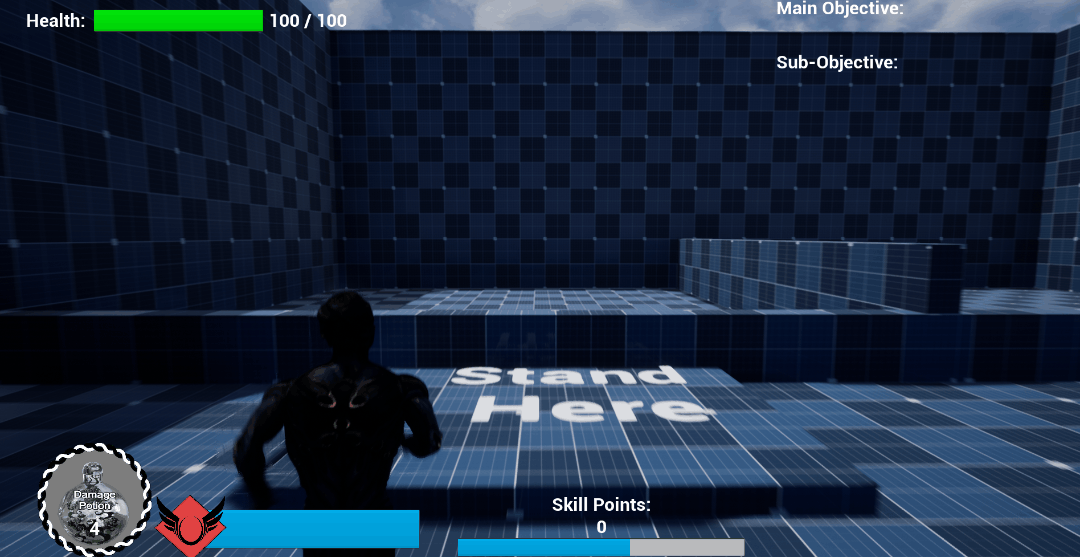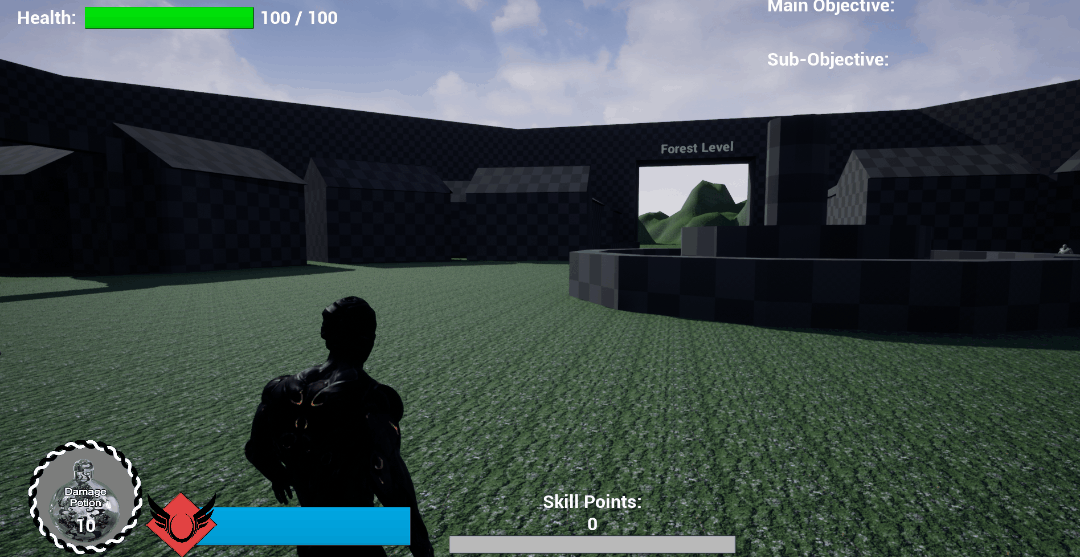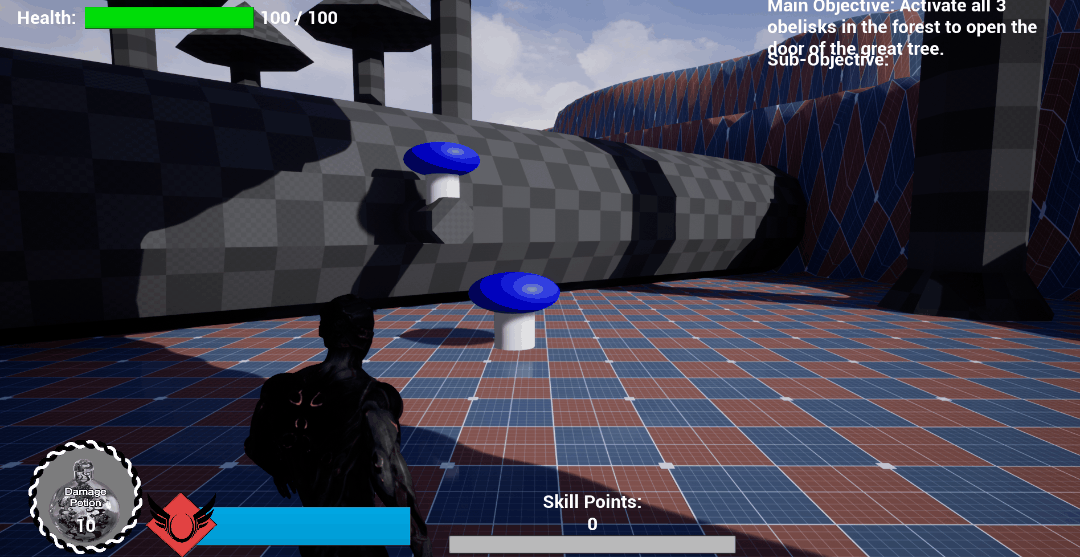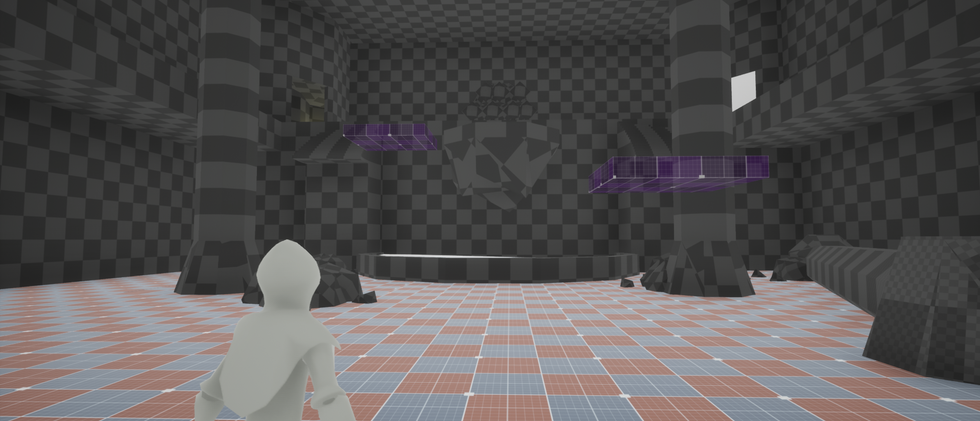
Splash
Splash! is a splash potion based third-person action game released on Steam. Players explore linear levels where they use their splash potions to deal AOE damage to enemies and defeat bosses to obtain new potions. This was a team-based capstone project persisting over 4 months where we went through different phases of production in the game making process. Our team consisted of 4 people taking on a design role and later grew when we received the help of some artists.

Prototyping

During this phase of production, we had to rapidly prototype the mechanics for our game. We knew that we wanted to focus on combat so we needed good enemy AI and different ways to interact with those enemy AI. My solution to this was to create a dynamic spawner system where designers can specify the number of waves they want from a spawner and each enemy that appears in those waves. This would allow me as a level designer and the rest of our team to create more unique and memorable combat encounters.

We needed to make sure that the player had a way to get away from enemies and kite them otherwise the player would feel powerless and enemies too strong. I added a sprint to the game so players had a way to get away from enemies and prevent themselves from getting overwhelmed.

Combat would get stale if there wasn't anything to interact within combat besides enemy AI so to counter this I created a poisonous mushroom that is present in the forest level of the game. Jumping on top of it launches the player up in the air and turns the mushroom into a deadly spore releasing object that can hurt the player and enemies. Throwing potions at it also does the same thing allowing the player to use these at chokepoints.

Finding the fun
During this phase of production, we had a solid base for our game and could begin the search to find the fun. To do this we began throwing together short action blocks that would focus on one mechanic to demonstrably prove it was fun. During this phase, I made 4 different action blocks.
The lava action block focused on having the player interact with valves in the middle of the level to make the lava rise. When the lava would rise to a new level enemies would spawn from the doors and force the player into combat. As the lava rises the player would have less and less area to run around on and evade enemies.
.png)
The mushroom action block focused on poisonous but bouncy mushrooms. I wanted to create a mechanic that could be used both inside and outside of combat that could break combat up and allow the player another approach to it. By jumping on one of these poisonous mushrooms you could bounce off it a little into the air and afterwards it would release damaging spores for 5 seconds that shred enemy HP and hurt the player if they are inside the radius. The action block consisted of having the player use the mushrooms to make it over areas they couldn't double jump past and gave them the option to kite enemies in combat to choke points where they would be forced to go through the spores of the mushrooms. The concepts from this action block were good enough that we carried them over into the forest level.
.png)
The moving platform action block was focused on platforms players could jump on that move on their own. The player would use the platforms to reach a new room where they would then ride platforms to defeat enemies they can't hit from below. After defeating those enemies the player would ride a massive platform to the end of the level during which enemies drop from the ceiling onto it and the player has to survive.
.png)
The heat geyser action block explored the use of hot air the player could ride on to float to areas they wouldn't be able to get to otherwise. Players would ride a heat geyser up a mountain where they would defeat enemies, continue on a string of heat geysers over lava, and eventually use heat geysers to ascend a massive spire at the end of the level. We ultimately decided to cut this mechanic because we didn't like how it controlled and felt it didn't mesh with the scope of the game.
.png)

Tutorial
.png)
.png)
Every game needs to teach it's players the mechanics so naturally, we needed a tutorial and we needed to do it right. We planned to have the player first load into the tutorial level when a new game is started. Since the player loads into the hub world after they finish a level and they can back to previous levels we decided to make the tutorial level accessible through the hub after completion in case the player ever wanted to replay it. This is how I got the idea of making it a system of waterways.
The tutorial would take place in the waterways under the city and end with the player climbing up the ladder and entering the main square where they always load in.
I wanted the tutorial level to be short, easy, and much more linear than the other levels in the game so the player could focus only on learning their core kit. Each new room would have a tutorial popup and teach the player one or two new mechanics in their kit and they would only be able to make it out of that room by utilizing the mechanic they have been taught. It would all then come together in one final room where the player has to use everything they've been taught to defeat waves of enemies after which holes in the wall would extend out allowing them to reach the ladder to the hub world and truly begin their adventure.

Sylphid Forest
.png)
After finishing the tutorial level, the player gains access to the game's first true level, Sylphid forest. Sylphid forest is inhabited by all types of monsters and home to Boongii, Lord of Shrooms, who resides within the great mushroom in the heart of the forest.
The forest level introduces two new mechanics to the player, movable blocks and the poisonous mushrooms. While making the game's levels I wanted to make sure each had its own identity, mechanics, and concepts. Since the forest level is the true first level of the game and it was a forest I wanted it to feel more open and free than Ara'Uk Volcano or Lohengrin Castle. When the player first loads into the level they see the great mushroom in the middle of the level, the door inside it is locked, and fork in the road. When the player approaches the fork in the road they have the choice to either go left or right. While this choice ultimately doesn't matter since the player has to go both ways, it allows them to choose freely which way they want to go themselves.
.png)
.png)
Going right allows the player to be introduced to the poisonous mushrooms and going left introduces the player to the movable blocks. Each area follows basic IPM building on top of the mechanics as the player progresses until they have total mastery over it by the end of the area. Once the player finishes one area, they activate the obelisk at the end, drop down into the middle of the level and where they walk around the great mushroom and return to the fork in the road to go the other way. However, at the end of each area there is a bridge leading inside the top of the great mushroom that has a locked door, this lets the player know they'll need to enter this place later.
After the player activates two of the three obelisks in the level, the doors at the top of the great mushroom open up allowing the player to complete the final area before the boss. Since each bridge inside is right by an obelisk at the end of areas one and two the player will see the doors open. Once inside both mechanics taught to the player are twisted together. Players have to fight through waves of enemies and eventually push one of the movable blocks through a room full of mushrooms to get to the second floor and activate the final obelisk. When the final obelisk is activated the main objective will change telling the player to head to the main door of the great mushroom.
Players will drop down to the entrance of the great mushroom, fight the boss of the area, Boongii, and then finish the level with a new potion and new level to play.

Lohengrin Castle
.png)
.png)
Being the final level in the game, Lohengrin Castle contains some of the most difficult puzzles, platforming, and combat in the game. Lohengrin Castle allows the player to make use of their newest potion, the stun potion, by having the player interact with boxes that will toggle moving platforms on and off. Additionally, disappearing and reappearing platforms are introduced as the second main mechanic of the level. Both mechanics twist together at the end of the level and culminate to create a boss fight with a dynamically changing battlefield.
The level begins with the player at the entrance to the castle and the introduction to the disappearing objects. The stairs inside the entrance have collapsed preventing access to the second floor. Player's notice the platforms floating in the room, toggling between dimensions and platform up to the second floor. Making their way to the west side of the castle, players reach and area on the outside overlooking the sea below. Parts of the castle have broken off the side and float above the sea. The player has to platform over this area and the disappearing rubble to make it to the next area.
The player is then introduced to the toggleable moving platforms. They have to toggle each platform on and off until they can create a path across the large gap in the room. Falling down puts the player into combat from where they can ride a moving platform back up and try again. Areas from this point on begin to utilize these mechanics in combat.
.png)
After proceeding through a short hallway, the player drops down into the knight's hall, an area filled with tables switching between dimensions. Some tables are on their sides to create walls and some are properly set up to create more cover and allow the player something to jump over. Dropping into the area starts the first main combat encounter where enemies spawn from set areas. During combat the tables toggle on and off, dynamically changing the cover in the arena and changing the paths the AI take to get to the player.
After completing the combat section, the player is elevated up to another part of the knight's hall. This part builds upon what the player has learned about the moving platforms, requiring the player to solve a puzzle to create and clear a path into the throne room.
.png)
.png)
The throne room is the second main combat encounter and builds upon what the player experienced in the knight's hall. Multiple walls inside the room move left and right while also disappearing and reappearing which keeps the player moving to different parts of the room during combat. Completing combat elevates the player up to the top of the room where the player creates a path with toggleable platforms to the throne which floats within the room. This time the platforms, just like the walls in the room, switch between realities requiring quick timing from the player to make it to the throne.
Passing through the portal to the boss room, players face off against Sven, King's Fallen Hand, a specter knight corrupted by black magic. The boss fight makes use of the disappearing platforms as after reaching certain HP thresholds, Sven will make some of the arena disappear and reappear, requiring the player to pay attention to where they move, otherwise they risk falling to their death.















